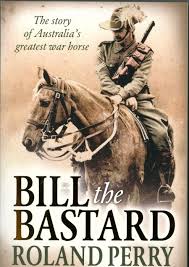Roland Perry’s book Bill the Bastard takes a novelistic approach to the story behind not only “Bill the Bastard” but the only person able to ride him, Major Michael Shanahan, DSO, in the Middle East during the First World War.
Perry writes the book in a very easy to read manner, allowing the book to be read within a day or two. The use of dialogue and fictional accounts keeps the reader engaged with the content and can easily picture themselves in the stirrups with the Cavalry. This approach supports the true history behind what occurred but can lead the reader to doubt some of the facts. I found myself stopping to research the facts whilst reading as no list of references was included to back up any claims.
Bill was a large horse, who was unable to be broken in by any trainer who attempted it. Likewise, he bucked any would be rider off his back within a matter of seconds, the longest to stay on was less than three minutes. Various characters are introduced and their interactions with Bill are noted including Bridges, Monash, Chauvel, Simpson & his donkey and the poet, Banjo Paterson. Paterson remains a key figure throughout the book, as one of the Officers in the remount section, who worked very closely with Bill and built a strong and trusting relationship. This approach proved to be the key when handling Bill.
Major Shanahan was an Officer who had the utmost respect for his men and was naturally followed and listened to by both his subordinates and his superiors. Through a respectful approach, Shanahan develops an incredible bond with Bill as he takes the time to understand him and his ways. Through devotion and persistence, Shanahan is eventually able to mount Bill and ride him successfully. Reading about his approach further solidified to me the importance of showing the utmost respect to anyone, in order to gain their trust and willingness to cooperate. In the military we tend to be very direct and mission focused which can lead to a lack of empathy and simply taking the time to step back, rethink and perhaps try the hearts and minds approach, which in our current age proves to be very beneficial.
The relationship between rider and horse develops throughout the book and the action from remaining as a packhorse in Gallipoli, to the lead horse in Cavalry Charges. During the Retreat from Romani, Shanahan whilst riding Bill had a further four Lighthorsemen who had lost their steed hanging off his stirrups, an impressive display of the trust Bill had in Shanahan, initially throwing riders who tried to mount him off his back.
My critique of Perry’s work is how the distinction between fact and fiction becomes blurred. As stated earlier this does help for easy reading but makes drawing historical conclusions difficult with no evidence to back up the claims. The book does, however, highlight the leadership and empathetic qualities possessed by Shanahan during the War which shaped the relationship he had with the horse, who given its immense strength, speed and agility proved to be an effective asset to the Cavalry.
I would recommend this book firstly to someone new to military history or factually heavy books as the transition between facts and interpersonal dialogue keeps it interesting. Secondly, this would be a great read for junior military leaders early in their career as they understand leadership and can use Major Shanahan as a role model for their own approach to leadership. Finally, anyone who is interested in learning about the animals that supported the Anzacs during the First World War and the important role they played.
Lachlan Rowe is a Maritime Warfare Officer in the Royal Australian Navy, in his Third Year at the Australian Defence Force Academy, studying a Bachelor of Business. At the Academy he fulfils the role of the Academy Cadet Headquarters J8 – Academics and Training, providing the link between UNSW and the Trainee Body, as well as the Military Training cell, promoting his passion for PME. Follow Lachlan on Twitter at @R_owey.

